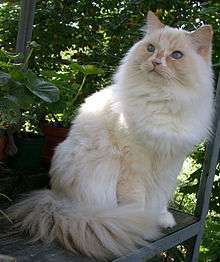Ragamuffin cat
| Ragamuffin | |
|---|---|
 | |
| Origin | United States |
| Breed standards | |
| CFA | standard |
| ACFA/CAA | standard |
| Domestic cat (Felis catus) | |
The Ragamuffin (often spelled RagaMuffin) is a breed of domestic cat. It is a variant of the Ragdoll cat and was established as a separate breed in 1994. Ragamuffins are notable for their friendly personalities and thick, rabbitlike fur.
General description
Ragamuffins are a muscular, heavy breed of cat needing approximately four to five years to fully mature.[1] The physical traits of the breed include a rectangular, broad-chested body with shoulders supporting a short neck. Ragamuffins come in all coat colors and patterns, with a medium-length coat that increases in length toward the stomach. Although the coat is thick and plush, it does not readily mat or clump and is easy to care for.
The head is a broad, modified wedge with a moderately rounded forehead and a nose dip. The body should appear rectangular with a broad chest and broad shoulders and moderately heavy muscling in the hindquarters, with the hindquarters being equally broad as the shoulders. There should be a fatty pad in the lower abdomen. Fur length is to be slightly longer around the neck and outer edges of the face, resulting in the appearance of a ruff. The fur should increase in length from the top of the head down through the shoulder blades and back, with the coat on the sides and stomach being medium to medium long. Every color and pattern is allowable, with or without white. Some color patterns, such as pure white, are rarer than others and are generally in greater demand.
History
In the 1960s, a regular non-pedigreed white domestic long haired cat named Josephine, who had produced several litters of typical kittens, was injured in a car accident and taken to a laboratory at the University of California. After she recovered, her next litter produced exceptionally friendly kittens. When the subsequent litter produced more of the same, Mrs. Ann Baker (an established cat breeder) purchased several kittens from the owner and set out to create what is now known as the (original) Ragdoll.
In the mid 1970s, after many of the original Ragdoll breeders left, Ann Baker decided to spurn traditional cat breeding associations. She trademarked the name "Ragdoll" for a new line of cats unrelated to the original Ragdoll and set up her own registry—International Ragdoll Cat Association (IRCA)—and imposed stringent standards on anyone who wanted to breed or sell cats under that name. The IRCA Ragdolls were also not allowed to be registered in other breed associations.
In 1994, a group of IRCA breeders decided to leave and form their own group because of increasingly strict breeding restrictions. Owing to Ann Baker's trademark on the name "Ragdoll", the group renamed its stock of IRCA Ragdoll cats, Ragamuffins. While the preferred name was Liebling cats, the name Ragamuffin was put forth as an alternative by one of the group founders and it was chosen.
In the spirit of bettering the breed's genetic health, personality and temperament, the group out-crossed to Persians, Himalayans, and domestic long haired cats. The group also allowed some out-crossing to original Ragdolls (which ended in 2010 for ACFA-recognized Ragamuffins). Only cats with at least one Ragamuffin parent and an ACFA-accepted out-cross currently qualify to be called Ragamuffins. Cat Fanciers' Association Ragamuffins may only have Ragamuffin parents.
The first cat association to accept the breed at full show champion status was the United Feline Organization (UFO), and while some major cat associations still refuse to accept the Ragamuffin as a recognized breed (primarily because of its close association with the Ragdoll), it was accepted into the American Cat Fanciers Association (ACFA). Finally, the Cat Fanciers' Association (CFA) accepted them into the Miscellaneous class in February, 2003 and advanced them to Championship Class in February, 2011.
Color forms
Ragamuffins come in all patterns and colors, although colorpoints are not allowed under CFA standards.[2] Their eyes can be any solid color, with some exhibiting heterochromia.
Personality
The only extreme allowed in this breed is their docile nature. Ragamuffins are friendly, attentive and affectionate, with a tendency to go limp when held. While not overly athletic, they enjoy playing and climbing scratching posts, and some will even run after and retrieve toys. They greet family members at the door and will follow familiar people around the house. Because of their gentle nature, it is considered advisable to keep Ragamuffins mostly indoors, to protect them from threats present in outdoor environments. These cats can be vocal at times. Fanciers who raise both Ragdolls and Ragamuffins claim that their temperaments are very similar. These cats adapt easily to a variety of territories.
References
- ↑ "Ragamuffin - Cat breeds, pictures & Info". Felinexpress.com. 2007-11-17. Retrieved 2014-08-06.
- ↑ Breed Standard: Ragamuffin Cat Fanciers Association
External links
| Wikimedia Commons has media related to Ragamuffin. |
| Look up Ragamuffin in Wiktionary, the free dictionary. |
- Ragamuffin kittens UK
- RagaMuffin Associated Group The original breed club begun by those who founded the Ragamuffin breed
- The RagaMuffin Kitten Breeders Society A group of RagaMuffin breeders and Ragamuffin lovers dedicated to raising authentic Ragamuffins while adhering to a code of ethics with respect to best breeding practices.
- Breed profile at IAMS cat breed guide
- CFA Ragamuffin Breed Profile
- Catster Ragamuffin Article